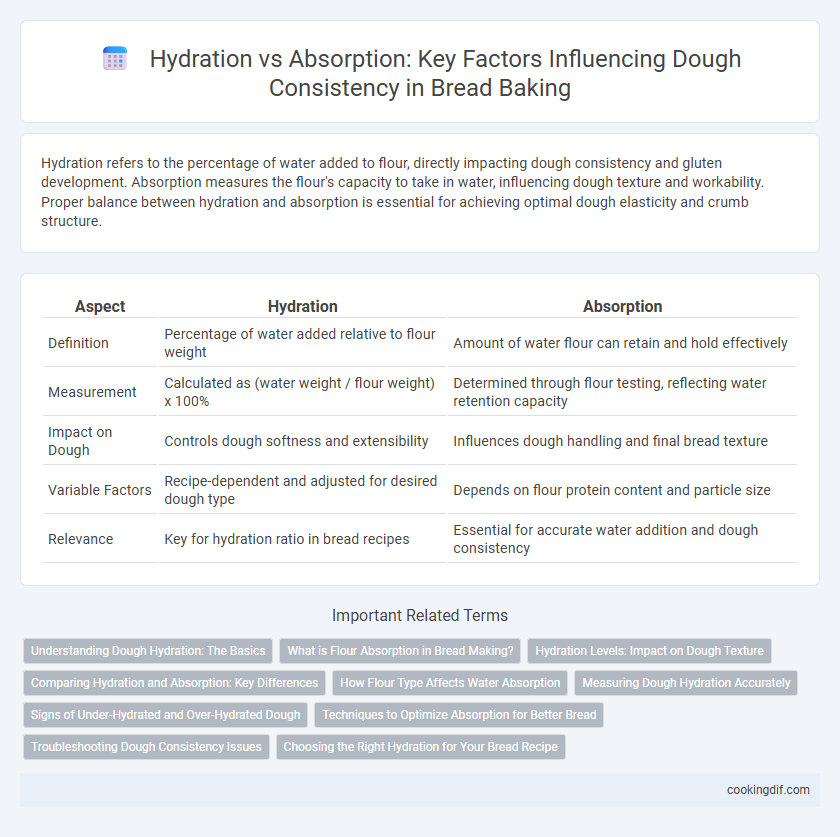Hydration refers to the percentage of water added to flour, directly impacting dough consistency and gluten development. Absorption measures the flour's capacity to take in water, influencing dough texture and workability. Proper balance between hydration and absorption is essential for achieving optimal dough elasticity and crumb structure.
Table of Comparison
| Aspect | Hydration | Absorption |
|---|---|---|
| Definition | Percentage of water added relative to flour weight | Amount of water flour can retain and hold effectively |
| Measurement | Calculated as (water weight / flour weight) x 100% | Determined through flour testing, reflecting water retention capacity |
| Impact on Dough | Controls dough softness and extensibility | Influences dough handling and final bread texture |
| Variable Factors | Recipe-dependent and adjusted for desired dough type | Depends on flour protein content and particle size |
| Relevance | Key for hydration ratio in bread recipes | Essential for accurate water addition and dough consistency |
Understanding Dough Hydration: The Basics
Dough hydration refers to the percentage of water relative to flour weight, directly impacting dough consistency and fermentation. Absorption measures flour's capacity to take in water, influenced by protein content and milling process, affecting dough handling and final bread texture. Precise control of hydration and absorption ensures optimal gluten development and crumb structure in artisan bread baking.
What is Flour Absorption in Bread Making?
Flour absorption in bread making refers to the amount of water flour can retain during dough mixing, significantly impacting dough consistency and bread texture. Higher flour absorption leads to softer, more hydrated dough, enhancing crumb softness and shelf life. Understanding flour absorption percentages, typically ranging from 55% to 65%, helps bakers adjust hydration levels for optimal dough development and baking results.
Hydration Levels: Impact on Dough Texture
Higher hydration levels in bread dough significantly affect the texture by creating a more open crumb structure with larger air pockets, resulting in a softer and chewier loaf. Lower hydration tends to produce denser, tighter dough with a firmer crust and smaller crumb holes. Precise control of hydration percentages, typically ranging from 60% to 85%, directly influences gluten development and dough extensibility essential for achieving desired texture outcomes.
Comparing Hydration and Absorption: Key Differences
Hydration measures the percentage of water added relative to flour weight, directly impacting dough softness and extensibility, while absorption quantifies the flour's capacity to take up water during mixing, influenced by protein content and bran levels. Higher hydration results in a wetter, stickier dough, essential for artisan bread like ciabatta, whereas higher absorption indicates flour's ability to hold more water without becoming overly slack. Understanding these differences optimizes dough consistency, leading to improved crumb structure and overall bread quality.
How Flour Type Affects Water Absorption
Different flour types significantly influence water absorption rates, with high-protein flours like bread flour absorbing more water due to their stronger gluten networks compared to all-purpose or cake flours. Whole wheat and rye flours also exhibit higher water absorption because of their bran and fiber content, which holds moisture more effectively. Understanding these variations is crucial for achieving optimal dough consistency and fermentation results in bread baking.
Measuring Dough Hydration Accurately
Measuring dough hydration accurately requires weighing both water and flour to calculate the precise hydration percentage, which directly affects dough consistency and baking outcomes. Hydration refers to the ratio of water to flour by weight, typically expressed as a percentage, influencing dough elasticity, texture, and crumb structure. Precise hydration measurement ensures consistent dough absorption, optimal gluten development, and desired bread quality.
Signs of Under-Hydrated and Over-Hydrated Dough
Under-hydrated dough appears stiff and dry, showing cracks on the surface and poor gluten development, resulting in dense bread with limited rise. Over-hydrated dough feels sticky and slack, often spreading out too much and failing to hold shape, which can lead to large air pockets and a gummy crumb. Proper balance in hydration ensures optimal gluten network formation and dough elasticity, producing a well-structured, airy loaf.
Techniques to Optimize Absorption for Better Bread
Optimizing dough absorption involves selecting high-protein flour, which enhances water retention and gluten development, resulting in improved dough consistency. Incorporating autolyse techniques, where flour and water rest before mixing, allows better hydration of flour particles, leading to increased absorption capacity. Adjusting mixing time and temperature also promotes optimal water uptake, yielding a more extensible and easier-to-handle dough for superior bread texture.
Troubleshooting Dough Consistency Issues
Dough hydration levels directly impact absorption rates, critical for achieving optimal dough consistency during bread making. Higher hydration doughs absorb more water, requiring adjustments in flour types and mixing techniques to avoid sticky or too stiff textures. Troubleshooting involves balancing water ratios with flour protein content, ensuring gluten development and proper fermentation for consistent crumb structure.
Choosing the Right Hydration for Your Bread Recipe
Selecting the appropriate hydration level for your bread dough directly influences its absorption capacity, impacting texture and crumb structure. Higher hydration percentages, typically ranging from 70% to 85%, enhance gluten development and produce a more open, airy crumb, favored in artisan-style breads. Balancing hydration with flour type--such as incorporating high-protein bread flour or whole wheat--ensures optimal dough consistency and improved fermentation performance.
Hydration vs Absorption for dough consistency Infographic

 cookingdif.com
cookingdif.com